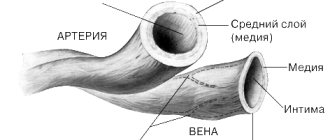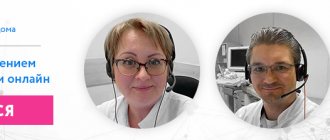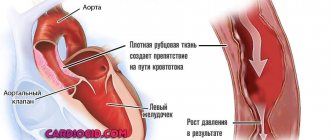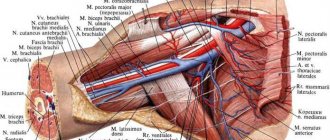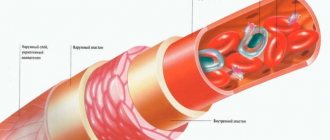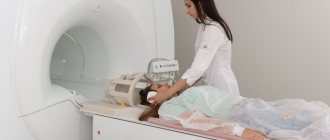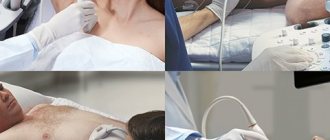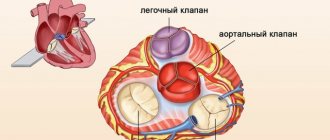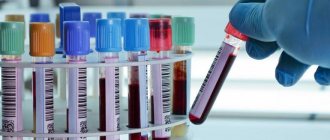What is the aorta
The aorta is the largest vessel in the human body, which carries blood from the heart to the organs and limbs. The upper section of the aorta runs inside the chest, this section is called the thoracic aorta . The lower part is in the abdominal cavity and is called the abdominal aorta . It delivers blood to the lower part of the body. In the lower abdomen, the abdominal aorta divides into two large vessels - the iliac arteries , which carry blood to the lower extremities.
The aortic wall consists of three layers: internal (intima), middle (media), external (adventitia).
The importance of veins in the human circulatory system
A feature of the veins is the transfer of red liquid that is not yet saturated with oxygen. They have less strong walls than the largest artery in the body. Accordingly, unlike arterial walls, venous walls experience less pressure. However, among the veins there is also one rather large one. The largest vein reaches a diameter of 2.5 centimeters. Small veins are usually called venules.
The pulmonary vein carries blood that is already saturated with oxygen. Each vein has internal valves that prevent backflow. A person experiencing valve dysfunction may develop varicose veins.
Abdominal aortic aneurysm
Abdominal aortic aneurysm is a chronic degenerative disease with life-threatening complications. An abdominal aortic aneurysm is defined as an increase in its diameter by more than 50% compared to the norm or a local bulging of its wall. Under the pressure of blood flowing through this vessel, the dilatation or bulging of the aorta may progress. The diameter of a normal aorta in the abdominal region is approximately 2 cm. However, at the site of an aneurysm, the aorta can be dilated to 7 cm or more.
Why is an aortic aneurysm dangerous?
An aortic aneurysm poses a major health risk as it can rupture. A ruptured aneurysm can cause massive internal bleeding, which in turn leads to shock or death.
An abdominal aortic aneurysm can cause other serious health problems. Blood clots (thrombi) often form in the aneurysm sac or parts of the aneurysm tear off, which move with the blood flow along the branches of the aorta to the internal organs and limbs. If one of the blood vessels becomes blocked, it can cause severe pain and lead to organ death or loss of a lower limb. Fortunately, if an aortic aneurysm is diagnosed early, treatment can be timely, safe and effective.
The role of the heart in blood circulation
The human circulatory system is a complex structure. Blood movement occurs due to the pressure difference between the arterial and venous systems. It is the heart that creates the pressure difference by pumping blood from the veins to the arteries. Arteries have virtually no smooth muscle, but have an elastic membrane that absorbs pressure changes. Thanks to elasticity and distensibility, the arteries are able to accept additional volumes of red liquid, leading to a rise in pressure by 50-60 mm.
Thanks to the elastic walls of the arteries, the required pressure is maintained, even if the heart is not pumping blood at the moment. This prevents it from falling to zero. Blood flow in the circulatory system circulates continuously. When the wall stretches, a pulsation occurs, which can be felt by applying a finger. Thanks to smooth muscle, arterioles quickly change their lumen, which allows them to create resistance to blood flow. This is why the arterioles account for the maximum pressure drop. In the venous system, blood appears through postcapillaries and veins.
In humans, due to the developed circulatory system, there are several mechanisms that promote venous return. The first is a basic mechanism that boils down to the use of pressure differences. There are also veins in skeletal muscles, and during their contraction, blood is squeezed out of the muscle. A similar mechanism is important for the legs, because due to the upright movement of the red liquid, it is necessary to overcome gravity. The third mechanism is the use of atmospheric pressure in the chest. When a person takes a breath, the blood in his body begins a return cycle. That is why it is generally accepted that veins play the role of capacitive vessels.
Finally, it should be noted the capillary system, which plays a large role in blood circulation. Capillaries are characterized by the highest permeability, so low molecular weight substances dissolve well in capillary blood. With the help of capillaries in the body, the exchange of substances between tissue fluid and plasma occurs. Capillary blood is characterized by phenomenal indicators. For example, one of the most amazing facts says that even with diffusion, the exchange surface of the capillaries of the human body ensures the pumping of 60 liters of blood per minute.
Types of aortic aneurysms
There are “true” and “false” aortic aneurysms. A true aneurysm develops due to the gradual weakening of all layers of the aortic wall. A false aneurysm is usually the result of trauma. It is formed from the connective tissue surrounding the aorta. The cavity of the false aneurysm is filled with blood through a crack in the aortic wall. The aortic walls themselves do not participate in the formation of an aneurysm.
Depending on the form there are:
- saccular aneurysm - expansion of the aortic cavity on only one side;
- spindle-shaped (fusiform) aneurysm - expansion of the aneurysm cavity on all sides;
- mixed aneurysm - a combination of saccular and fusiform forms.
Causes and risk factors for the development of abdominal aortic aneurysm
The causes of the development of abdominal aortic aneurysms are very diverse. The most common cause of aneurysm development is atherosclerosis. Atherosclerotic aneurysms account for 96% of the total number of all aneurysms. In addition, the disease can be either congenital (fibromuscular dysplasia, Erdheim's cystic medianecrosis, Marfan syndrome, etc.) or acquired (inflammatory and non-inflammatory). Inflammation of the aorta occurs when various microorganisms invade (syphilis, tuberculosis, salmonellosis, etc.) or as a result of an allergic-inflammatory process (nonspecific aortoarteritis). Non-inflammatory aneurysms most often develop with atherosclerotic lesions of the aorta. Less commonly, they are the result of injury to its wall.
Risk factors for developing an aneurysm
- Arterial hypertension;
- Smoking;
- The presence of aneurysms in other family members. Which indicates the role of hereditary factors in the development of this disease;
- Gender: men over 60 years of age (abdominal aortic aneurysms occur less frequently in women).
Why does high blood pressure occur?
High (high) blood pressure is commonly called hypertension. When pumping power becomes excessive, the human body becomes overwhelmed by its own blood. The body is unable to function normally, which can have harmful consequences. Hypertension is common among residents of developed countries where there is a stressful standard of living.
The older a person gets, the higher the risk of developing hypertension. Even young people sometimes experience high blood pressure. Vessels may experience stress due to a large release of hormones (adrenaline and norepinephrine). Problems with high blood pressure occur in those who like to drink beer, causing damage to the kidneys. The problem with hypertension is that it almost always goes silent. People who lead a sedentary lifestyle, gain excess weight, or consume a lot of alcohol and salty foods often do not even suspect that they are developing hypertension. Meanwhile, the higher the pressure, the higher the risk of vascular damage. The most terrible consequences of hypertension are stroke, the development of heart or kidney failure, and myocardial infarction.
Symptoms and signs of abdominal aortic aneurysm
In most patients, abdominal aortic aneurysms occur without any symptoms and are an incidental finding during examinations and operations for other reasons.
When signs of an aneurysm develop, the patient experiences one or more of the following symptoms:
- A feeling of pulsation in the abdomen, similar to a heartbeat, an unpleasant feeling of heaviness or fullness.
- Dull, aching pain in the abdomen, in the navel area, usually on the left.
Indirect signs of abdominal aortic aneurysm are important :
- Abdominal syndrome. Manifested by the appearance of belching, vomiting, unstable stool or constipation, lack of appetite and weight loss;
- Ischioradic syndrome. Manifested by lower back pain, sensory disturbances and movement disorders in the lower extremities;
- Syndrome of chronic ischemia of the lower extremities. Manifests itself in the appearance of pain in the muscles of the lower extremities when walking, sometimes at rest, coldness of the skin of the lower extremities;
- Urological syndrome. It manifests itself as pain and heaviness in the lower back, difficulty urinating, and the appearance of blood in the urine.
Harbingers of rupture may be increased abdominal pain.
When an aneurysm ruptures, the patient suddenly feels an increase or appearance of abdominal pain, sometimes “radiating” to the lower back, groin area and perineum, as well as severe weakness and dizziness. These are symptoms of massive internal bleeding. The development of such a situation is life-threatening! The patient needs emergency medical care!
Diagnosis of abdominal aortic aneurysms
Most often, abdominal aortic aneurysms are detected by ultrasound examination of the abdominal organs. Typically, the discovery of an aneurysm is an incidental finding. If a doctor suspects a patient has an aortic aneurysm, modern diagnostic methods are used to clarify the diagnosis.
Methods for diagnosing abdominal aortic aneurysm
- Computed tomography in angio mode;
- Magnetic resonance imaging in angio mode;
- X-ray contrast aorto- and angiography;
- Ultrasound duplex or triplex angioscanning of the abdominal aorta.
If necessary, the abdominal and thoracic aorta is examined.
Functions
The aortic arch and its branches provide the delivery of oxygenated blood to other arterial trunks presented in the table:
| Vessels | Blood supply area |
| Carotid arteries |
|
| Subclavian arteries |
|
Additional functions of the vessel:
- discharge of blood from the pulmonary trunk during intrauterine development (with a closed pulmonary circulation);
- maintaining standard blood pressure levels.
Treatment methods for aortic aneurysm
There are several methods for treating aortic aneurysm. It is important to know the advantages and disadvantages of each of these techniques. Approaches to the treatment of abdominal aortic aneurysms:
Monitoring the patient over time
If the aneurysm is less than 4.5 cm in diameter, the patient is recommended to be monitored by a vascular surgeon, since the risk of surgery exceeds the risk of rupture of the aortic aneurysm. Such patients should undergo repeated ultrasound examinations and/or computed tomography at least once every 6 months.
When the aneurysm diameter is more than 5 cm, surgical intervention becomes preferable, since as the size of the aneurysm increases, the risk of aneurysm rupture increases.
If the size of the aneurysm increases by more than 1 cm per year, the risk of rupture increases and surgical treatment also becomes preferable.
Open surgery: aneurysm resection and aortic replacement
Surgical treatment is aimed at preventing life-threatening complications. The risk of surgery is associated with possible complications that include heart attack, stroke, limb loss, acute intestinal ischemia, male sexual dysfunction, embolization, prosthetic infection, and renal failure.
The operation is performed under general anesthesia. The essence of the operation is to remove the aneurysmal expansion and replace it with a synthetic prosthesis. The average mortality rate for open procedures is 3-5%. However, it may be higher if the renal and/or iliac arteries are involved in the aneurysm, as well as due to the patient’s concomitant pathology. Observation in the postoperative period is carried out once a year. Long-term treatment results are good.
Endovascular repair of aortic aneurysm: installation of a stent graft
Endoprosthetics of aortic aneurysm is a modern alternative to open surgery.
The operation is performed under spinal or local anesthesia through small incisions/punctures in the groin areas. Through the above approaches, catheters are inserted into the femoral artery under X-ray control. According to which, in the future, the endoprosthesis will be brought to the aneurysmal extension. An endoprosthesis or stent-graft of the abdominal aorta is a mesh frame made of a special alloy and wrapped in synthetic material. The last stage of the operation is the installation of a stent graft at the site of the aneurysmal expansion of the aorta. Eventually, the aneurysm is “switched off” from the bloodstream and the risk of rupture becomes unlikely. After aortic replacement, the patient is observed in the hospital for 2-4 days and discharged.
This technique allows to reduce the incidence of early complications, shorten the length of patient stay in the hospital and reduce the mortality rate to 1-2%. Observation in the postoperative period is carried out every 4-6 months using ultrasound techniques, CT angiography, X-ray contrast angiography. The endovascular treatment method is certainly less traumatic. About 40,000 such operations are performed annually in the United States alone.
Thus, the choice of treatment method for abdominal aortic aneurysm is based on the individual characteristics of the patient.
